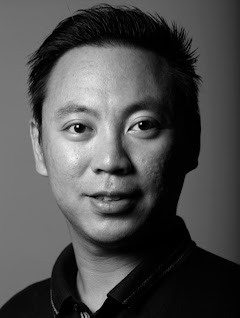Beat
Company news and the economy form the bread and butter of my work in Singapore, which is one of Asia’s regional financial centers. But whenever I get a chance, I indulge in street photography to capture everyday life in the rapidly changing city.
One Shot

“It’s not exactly newsy, but I love the colours, dots and patterns in this image, and the quirky silhouettes of the two cleaners’ bodies. It makes my day.”
Profile
I took my first photos about ten years ago, during a semester at university when I was required to photograph architectural details of Chinese pre-war shops in Singapore. It was the start of the digital age, but I couldn’t afford digital equipment so I used a mechanical camera. All my photos on that roll of film were dark and blurry but it was great fun and I enjoyed the sense of anticipation as I waited for the negatives and prints from the lab. I’ve been hooked since then.
I took up short courses at a photography club, which taught skills ranging from basic photography to dark room printing. Eventually I became an assistant to a commercial advertising photographer. I handled logistics (lights, props, equipment, drinks, meals) on location and scanned slides for the archive in the office whenever there were no shoots. I did not take a single picture during my time as an assistant but learnt much more about photography than during the courses I attended.
I started out as a freelancer in Cambodia, doing features that I hoped to sell to in-flight magazines back home. My first published work was a story on Cambodian kickboxers, whom I followed for a week in Phnom Penh. It wasn't a groundbreaking or terribly original story, but it was a great experience learning how to pitch to magazine editors and seeing my work in print at the newsstand.
Last year I went to the Philippines to cover the aftermath of Typhoon Haiyan. It was my first natural disaster assignment and it really was an eye-opener for me. Entire villages were flattened, cars were hanging from trees, and entire ships were washed aground. I saw for myself how destructive nature can be and how challenging it was for aid workers and others to operate in an environment with scarce water, food, fuel and electricity. I also realised how important my job was there – I needed to tell the stories of those affected through my pictures so that more people would be aware of the situation.
As a newswire photographer, one must be able to handle all kinds of assignments. Big stories where you get to travel are definitely exciting because they tend to be important (hence the travel), and you get to photograph with an outsider’s eyes. But finding the stories in your own backyard can also be very exciting and rewarding when you are able to spend a lot of time with the subject and go beyond the surface.
I am so used to Singapore because it’s where I was born and bred, but while I’m taking pictures I try to put myself in the shoes of someone who has never been to here.
One thing I’ve learnt from the veterans in the field – always stay calm. Instead of just reacting, slow down and think before shooting.
This is a very competitive business and the photographers I respect the most are the ones who are confident in their work and are unselfish in sharing what they know.
Behind the Scenes

